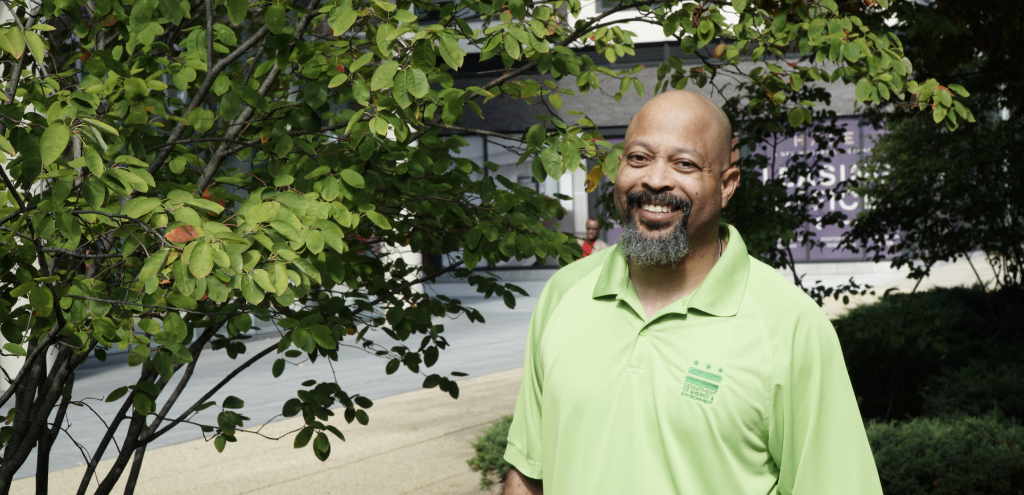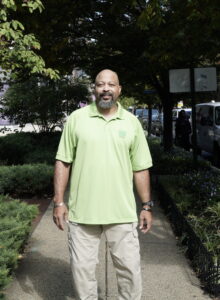THE LEAFLET

Behind the Scenes at DOEE
At Casey Trees, we work closely with the city’s Department of Energy and Environment (DOEE). Among other cooperative activities, we plant free trees as part of DOEE’s RiverSmart Homes program, which offers several ways for DC residents to mitigate stormwater runoff on their property and bring a host of other great benefits to their home and community.
We are very proud of the work we have accomplished in partnership with DOEE to increase canopy coverage across DC, and of the commitment that the District government has made to this work. Recently, we sat down with Richard Jackson, newly appointed Director of DOEE, to learn more about him and what his goals are for the future of the department.
Can you tell us a bit about your career and how you got to DOEE?
I came into DOEE in 2008 as a hazardous waste inspector. Soon after, I became Branch Chief for the hazardous waste branch and from there, moved into the Associate Director position for the Toxic Substances Division with DOEE, and then the Deputy Director for Environmental Services.
From Deputy Director, I moved into the Senior Deputy position for the agency, and then from Senior Deputy to Director. So, over the course of that, roughly 15-year time frame, I transitioned at about, 3 to 4 years a clip, depending on the position.
What has been a favorite project of yours?
Well, I bring passion to all the projects I work on but the most impactful would be the Anacostia River sediment project. I was tasked with it in 2013 as the Associate Director and I convened a team that has been overseeing the project throughout the last 10 years.
We looked at the entire 9.2-mile length of the Anacostia River. We started at the confluence point to the Washington Channel and then to the Potomac and conducted tests to determine what chemicals were of concern. The primary contaminants we found in our initial study were PCBs.
[Polychlorinated biphenyls (PCBs) are a group of human-made chemicals that were commonly used in building materials and electrical equipment before 1980. Caulk, paint, glues, plastics, fluorescent lighting ballasts, transformers and capacitors are examples of products that may contain PCBs.]
And so, we conducted the study to determine where the hotspots were in the river within the nine-mile stretch, and completed an interim record of decision, and the remedial investigation of feasibility study (RI/FS).
Now, we’re in the process of refining the areas that need to be cleaned up. Hopefully, by late 2024 we will begin to execute the actual cleanup of the river, specifically the hotspots — the Kingman Lake area, parts in the main stem, and portions in the Washington Channel that have been identified.
Again, we started in 2013 conducting a bathymetric survey, which took a picture of the entire riverbed. Now, 10 years later, we’re finally putting shovels in the ground. It may seem like a long time, but it’s one of the quicker remediations being done throughout the country.
We keep plowing forward and it continues to be an exciting project for us. The team is dedicated and likes what they do, and that’s important because they continue to discover and learn new things.
Now that you’re the Director, what’s your vision for the Department?
In a nutshell — making improvements to the work and projects we are currently doing so that we can have a real impact on the lives and livelihoods of the residents of the city and ultimately set the standards for responsible sustainable practices. With the reality of expected tighter budgets how can we, as an agency, be better at, and get better results with, what we are already doing? This is an ongoing discussion with my management team.
Here’s one example: We had two mold inspectors covering complaints for the entire city. They were okay for the first year, but in the second year, they received approximately 500-600 complaints. So, you had two people handling that level of complaints, plus maintaining the database of all the people that do the work and those who did the assessment after the work, and outreach. Fortunately, the Council gave us additional funding and we hired three additional mold inspectors. So now with a team of five the program is getting better as we are being more efficient in serving the residents. We have similar issues in many other areas and so my goal is to work alongside my team to improve in all areas.
What is an important part of your leadership at DOEE?
An important part of my leadership is to give my team the opportunity to grow at the agency. Their growth is one of the most important things to me. We have a lot of younger staff here and DOEE is simply a part of their professional journey. While they are here, I want to challenge them and take advantage of their skills, but I also want them to grow and develop new and better skills so that when they move to the next chapter of their professional lives, they will be better equipped to handle challenges. That is big for me. Providing an environment that fosters a strong sense of security that will allow my managers to become strong, confident and successful leaders.
How do you see trees fitting in with the vision for DOEE?
As I mentioned earlier, my vision is to improve upon what we already have going on. We have a good and strong relationship with Casey Trees and under my leadership, we will find common grounds to make things even better. What you do is vital to our city’s Sustainable DC goal, and we will extend our resources to you to help the city achieve its goals. That’s a win-win for everybody.
Is there anything else you’d like to share with us?
One of the things I’m committed to work on is identifying ways to improve and expand our outreach efforts. We will customize our approach to outreach by identifying our respective audiences, crafting messages that will resonate with them, and working closely with sister agencies, ANCs, libraries, and community- and faith-based organizations, to get the information on our programs and partnerships out to the public. We want the public, for example, to know about the importance of trees and the tree canopy in the District.
I don’t think many residents truly understand how the tree canopy contributes to their personal well-being as well as that of the city in general. Tree canopy in an urban environment like the District offers environmental benefits as it acts as a natural air purifier. It offers social benefits as it provides city residents with a natural outdoor escape to relax and de-stress. It offers health benefits to people with respiratory issues as well as cooling down the environment on hot days. And it also has economic benefits as it can increase the value of your property. So, messages such as those must be targeted at different audiences to get their buy in.
Not everybody does things for the same reason. Even if they’re all trying to get the same result, there’s multiple paths to get there. So, we need to identify those paths and then once we identify them, we’ll work on creating that message so that it makes sense for everybody.
Lastly, do you have a favorite green space in DC?
For me, I enjoy riding the trails. I enjoy the scenery. I’ll take the Metro Branch trail through Kingman, and then try to make my way over to Kenilworth. So, that’s my escape on the weekends.
I was at the National Arboretum recently for a meeting. And, once you get deep in it, you are in the woods, you know – you’re out there. And being in the woods offers me a complete mental reset. It takes me to a place where I can relax, stay calm, and decompress and refocus. I know my weekends – most of them at least, will be decompressing somewhere thick in the woods.
